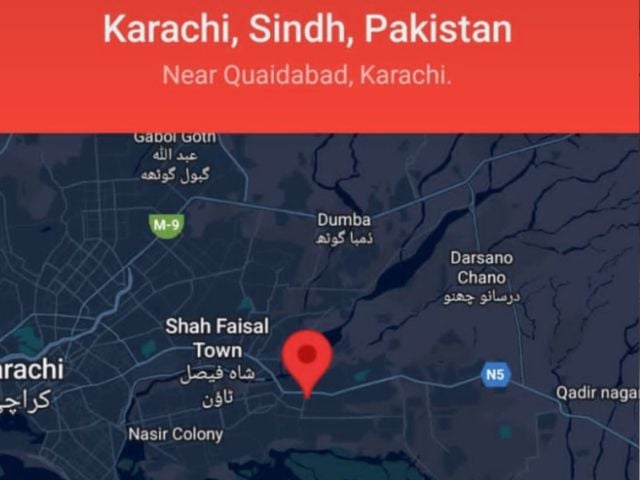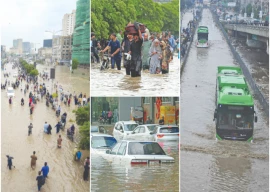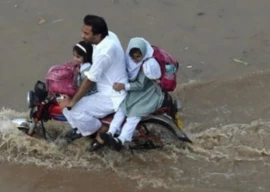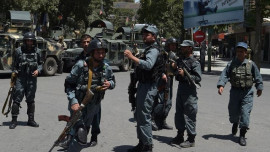
A total of 19 mild earthquake tremors have been recorded since Sunday night, an event unprecedented in Karachi city's history.
The Early Tsunami Warning Cell Karachi has released official data, confirming that the strongest earthquake measured 3.6 magnitude, while the weakest was recorded at 2.1 magnitude.
Out of these, 11 tremors were recorded in the Malir district, while the remaining were felt in the southwestern part of Korangi and the northeastern areas of DHA.
Experts attribute the repeated seismic activity to shifts in underground tectonic layers. These tremors are caused by the release of energy generated by low-level seismic movement beneath the earth’s surface.
In response, residents in several streets and neighborhoods of Malir and Quaidabad have opted to stay outdoors, setting up temporary shelters and tents in open areas. Women gathered throughout Monday to recite the Holy Quran, praying for safety.
Commissioner Karachi Syed Hassan Naqvi urged residents to stay calm and not believe in rumours circulating on social media.
Read: Light earthquake jolts Karachi; no damage reported
According to the National Tsunami Center (Pakistan Meteorological Department), these tremors are not a warning sign of a major natural disaster, but rather a natural geological process. This activity may actually help balance the local fault line for years to come.
Ameer Haider Laghari, head of the National Tsunami Center, explained that the Quaidabad fault line remains active, and the situation could continue for up to a week.

The year’s first earthquake in Karachi was recorded on March 31, registering 4.7 magnitude with a depth of 19 kilometers. In contrast, this latest sequence has shown a consistent pattern, specifically in Malir and Quaidabad, where nine low- to moderate-intensity earthquakes occurred within two days. Several parts of the city felt the tremors.
Chronological details of the seismic events include:
-
Sunday, 5:33 PM – Magnitude 3.6, depth 10 km, epicenter: Qaidabad
-
Sunday, 10:29 PM – Magnitude 3.2, depth 10 km, epicenter: Qaidabad
-
Sunday, 11:45 PM – Magnitude 3.1, depth 10 km, epicenter: 40 km southeast of Malir
-
Monday, 1:06 AM – Magnitude 3.2, depth 12 km, epicenter: Gadap Town
-
Monday, 11:04 AM – Magnitude 3.2, epicenter: Qaidabad
-
Monday, 12:17 PM – Magnitude 2.2, depth 29 km, epicenter: southeast Malir
-
Monday, 1:11 PM – Magnitude 2.4, depth 188 km, epicenter: 11 km east of Malir
-
Monday, 1:38 PM – Magnitude 2.9, depth 5 km, epicenter: near DHA
-
Monday, 9:49 PM – Magnitude 3.0, depth 13 km, epicenter: 30 km east of DHA
In an interview with Express News, Ameer Haider Laghari noted that the quakes stem from natural tectonic shifts, where built-up energy in the earth is gradually released—causing seismic activity. He emphasized that this is a global geological process, occurring in some regions more frequently than others.
He recalled similar tremors in northern Pakistan, where activation of a fault line triggered panic in Islamabad and nearby areas for several days.
READ MORE: 4.6-magnitude quake jolts northwestern Pakistan
Laghari assured that the Karachi earthquakes are low-intensity, and each subsequent tremor has been less intense than the previous one. He also clarified that these are not aftershocks, as such minor quakes don’t usually produce aftershocks—they are independent seismic events.
He warned that Malir, Quaidabad, and surrounding areas may continue to feel tremors for two more days to a week. Pakistan lies in a shallow earthquake zone, meaning most quakes occur at low depths.
He also highlighted other active fault lines in the region, including the Landhi fault line, Thana Bula Khan, and the Western Kirthar Range Plate Foundry Fault Line.
As a precaution, he advised that residents of structurally weak buildings should evacuate quickly during tremors. People should avoid standing near walls, and instead, seek open spaces for temporary shelter.
Providing broader context, Dr. Adnan Khan, Associate Professor and Geologist at the University of Karachi, told Express Tribune that these were minor tremors and not a cause for alarm.
He explained that Karachi is situated on a passive tectonic margin, far from any major fault line, making large, destructive earthquakes highly unlikely in the region.
“These tremors are classified as mild, resulting from minor tectonic movements and stress accumulation deep within the Earth's crust,” Dr. Khan stated.
READ MORE: 3.6 magnitude quake jolts Quetta
He also linked these movements indirectly to Himalayan tectonic activity, where the northward shift of the mountain range—by 4 to 5 cm annually—can generate distant tectonic pressures, occasionally manifesting as low-intensity quakes even in far-off areas like Karachi.
Dr. Khan further pointed to human factors that may play a subtle role in altering subterranean stability, including industrial waste incineration and excessive groundwater extraction, both of which can influence local seismic behavior over time.
While the scientific consensus remains that these tremors are harmless, both Laghari and Dr.Khan stressed the importance of basic safety awareness.
Dr. Khan also advised citizens to remain calm during any such tremor and to immediately move to open areas, staying away from walls, foundations, or tall structures.
Meanwhile, at least 216 prisoners escaped from District Malir Jail in Karachi on Monday night after earthquake tremors led to a temporary evacuation of inmates, Jail Superintendent Arshad Shah confirmed early Tuesday.
According to Shah, the prisoners exploited the confusion during the evacuation to flee. In response, security forces including police, Rangers, and Frontier Corps (FC) were swiftly deployed to secure the jail and prevent further escapes.
Sindh Inspector General Ghulam Nabi Memon reported that 78 of the escapees have been recaptured, while a major search operation is underway to find the remaining fugitives.
Security at the facility has since been tightened, with Rangers taking charge of the perimeter and police strengthening security inside the prison.

1736246483-0/Express-Tribune---News-Desk-(1)1736246483-0-165x106.webp)























COMMENTS
Comments are moderated and generally will be posted if they are on-topic and not abusive.
For more information, please see our Comments FAQ